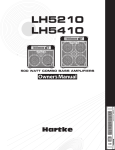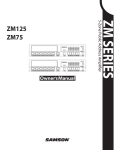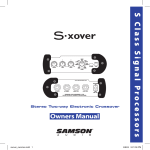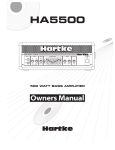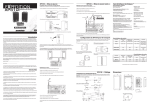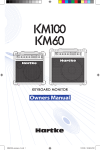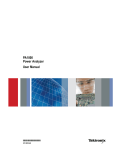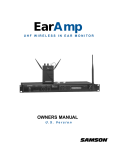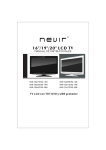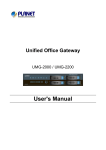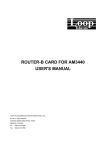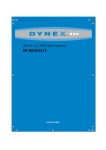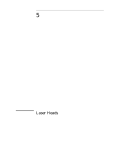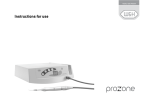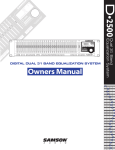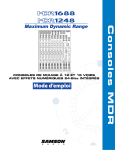Download D-3500 User Manual (v1.2) PDF
Transcript
� �� � � �� ��� � � �� ��� �� � ��� ������ ������ ����� ������ ���� ��� ����� ��� ������ ������ ��� DIGITAL DUAL 15 BAND PARAMETRIC EQ /FEEDBACK MANAGEMENT SYSTEM D3500_ownman_v1_2.indd 1 9/4/05 5:19:53 PM Safety Instructions/Consignes de sécurité/Sicherheitsvorkehrungen/Instrucciones de seguridad WARNING: To reduce the risk of fire or electric shock, do not expose this unit to rain or moisture. To reduce the hazard of electrical shock, do not remove cover or back. No user serviceable parts inside. Please refer all servicing to qualified personnel.The lightning flash with an arrowhead symbol within an equilateral triangle, is intended to alert the user to the presence of uninsulated "dangerous voltage" within the products enclosure that may be of sufficient magnitude to constitute a risk of electric shock to persons. The exclamation point within an equilateral triangle is intended to alert the user to the presence of important operating and maintenance (servicing) instructions in the literature accompanying the product. Important Safety Instructions 1. Please read all instructions before operating the unit. 2. Keep these instructions for future reference. 3. Please heed all safety warnings. 4. Follow manufacturers instructions. 5. Do not use this unit near water or moisture. 6. Clean only with a damp cloth. 7. Do not block any of the ventilation openings. Install in accordance with the manufacturers instructions. 8. Do not install near any heat sources such as radiators, heat registers, stoves, or other apparatus (including amplifiers) that produce heat. 9. Do not defeat the safety purpose of the polarized or grounding-type plug. A polarized plug has two blades with one wider than the other. A grounding type plug has two blades and a third grounding prong. The wide blade or third prong is provided for your safety. When the provided plug does not fit your outlet, consult an electrician for replacement of the obsolete outlet. 10. Protect the power cord from being walked on and pinched particularly at plugs, convenience receptacles and at the point at which they exit from the unit. 11. Unplug this unit during lightning storms or when unused for long periods of time. 12. Refer all servicing to qualified personnel. Servicing is required when the unit has been damaged in any way, such as power supply cord or plug damage, or if liquid has been spilled or objects have fallen into the unit, the unit has been exposed to rain or moisture, does not operate normally, or has been dropped. ATTENTION: Pour éviter tout risque d’électrocution ou d’incendie, ne pas exposer cet appareil à la pluie ou à l’humidité. Pour éviter tout risque d’électrocution, ne pas ôter le couvercle ou le dos du boîtier. Cet appareil ne contient aucune pièce remplaçable par l'utilisateur. Confiez toutes les réparations à un personnel qualifié. Le signe avec un éclair dans un triangle prévient l’utilisateur de la présence d’une tension dangereuse et non isolée dans l’appareil. Cette tension constitue un risque d’électrocution. Le signe avec un point d’exclamation dans un triangle prévient l’utilisateur d’instructions importantes relatives à l’utilisation et à la maintenance du produit. Consignes de sécurité importantes 1. Veuillez lire toutes les instructions avant d’utiliser l’appareil. 2. Conserver ces instructions pour toute lecture ultérieure. 3. Lisez avec attention toutes les consignes de sécurité. 4. Suivez les instructions du fabricant. 5. Ne pas utiliser cet appareil près d’une source liquide ou dans un lieu humide. 6. Nettoyez l’appareil uniquement avec un tissu humide. 7. Veillez à ne pas obstruer les fentes prévues pour la ventilation de l’appareil. Installez l’appareil selon les instructions du fabricant. 8. Ne pas installer près d’une source de chaleur (radiateurs, etc.) ou de tout équipement susceptible de générer de la chaleur (amplificateurs de puissance par exemple). 9. Ne pas retirer la terre du cordon secteur ou de la prise murale. Les fiches canadiennes avec polarisation (avec une lame plus large) ne doivent pas être modifiées. Si votre prise murale ne correspond pas au modèle fourni, consultez votre électricien. 10. Protégez le cordon secteur contre tous les dommages possibles (pincement, tension, torsion,, etc.). Veillez à ce que le cordon secteur soit libre, en particulier à sa sortie du boîtier. 11. Déconnectez l’appareil du secteur en présence d’orage ou lors de périodes d’inutilisation prolongées. 12. Consultez un service de réparation qualifié pour tout dysfonctionnement (dommage sur le cordon secteur, baisse de performances, exposition à la pluie, projection liquide dans l’appareil, introduction d’un objet dans le boîtier, etc.). ACHTUNG: Um die Gefahr eines Brandes oder Stromschlags zu verringern, sollten Sie dieses Gerät weder Regen noch Feuchtigkeit aussetzen.Um die Gefahr eines Stromschlags zu verringern, sollten Sie weder Deckel noch Rückwand des Geräts entfernen. Im Innern befinden sich keine Teile, die vom Anwender gewartet werden können. Überlassen Sie die Wartung qualifiziertem Fachpersonal.Der Blitz mit Pfeilspitze im gleichseitigen Dreieck soll den Anwender vor nichtisolierter “gefährlicher Spannung” im Geräteinnern warnen. Diese Spannung kann so hoch sein, dass die Gefahr eines Stromschlags besteht. Das Ausrufezeichen im gleichseitigen Dreieck soll den Anwender auf wichtige Bedienungs- und Wartungsanleitungen aufmerksam machen, die im mitgelieferten Informationsmaterial näher beschrieben werden. Wichtige Sicherheitsvorkehrungen 1. Lesen Sie alle Anleitungen, bevor Sie das Gerät in Betrieb nehmen. 2. Bewahren Sie diese Anleitungen für den späteren Gebrauch gut auf. PRECAUCION: Para reducir el riesgo de incendios o descargas, no permita que este aparato quede expuesto a la lluvia o la humedad. Para reducir el riesgo de descarga eléctrica, nunca quite la tapa ni el chasis. Dentro del aparato no hay piezas susceptibles de ser reparadas por el usuario. Dirija cualquier reparación al servicio técnico oficial. El símbolo del relámpago dentro del triángulo equilátero pretende advertir al usuario de la presencia de “voltajes peligrosos” no aislados dentro de la carcasa del producto, que pueden ser de la magnitud suficiente como para constituir un riesgo de descarga eléctrica a las personas. El símbolo de exclamación dentro del triángulo equilátero quiere advertirle de la existencia de importantes instrucciones de manejo y mantenimiento (reparaciones) en los documentos que se adjuntan con este aparato. Instrucciones importantes de seguridad 1. Lea todo este manual de instrucciones antes de comenzar a usar la unidad. 2. Conserve estas instrucciones para cualquier consulta en el futuro. 3. 4. 5. 6. 7. 3. 4. 5. 6. 7. 8. 9. 10. 11. 12. Bitte treffen Sie alle beschriebenen Sicherheitsvorkehrungen. Befolgen Sie die Anleitungen des Herstellers. Benutzen Sie das Gerät nicht in der Nähe von Wasser oder Feuchtigkeit. Verwenden Sie zur Reinigung des Geräts nur ein feuchtes Tuch. Blockieren Sie keine Belüftungsöffnungen. Nehmen Sie den Einbau des Geräts nur entsprechend den Anweisungen des Herstellers vor. Bauen Sie das Gerät nicht in der Nähe von Wärmequellen wie Heizkörpern, Wärmeklappen, Öfen oder anderen Geräten (inklusive Verstärkern) ein, die Hitze erzeugen. Setzen Sie die Sicherheitsfunktion des polarisierten oder geerdeten Steckers nicht außer Kraft. Ein polarisierter Stecker hat zwei flache, unterschiedlich breite Pole. Ein geerdeter Stecker hat zwei flache Pole und einen dritten Erdungsstift. Der breitere Pol oder der dritte Stift dient Ihrer Sicherheit. Wenn der vorhandene Stecker nicht in Ihre Steckdose passt, lassen Sie die veraltete Steckdose von einem Elektriker ersetzen. Schützen Sie das Netzkabel dahingehend, dass niemand darüber laufen und es nicht geknickt werden kann. Achten Sie hierbei besonders auf Netzstecker, Mehrfachsteckdosen und den Kabelanschluss am Gerät. Ziehen Sie den Netzstecker des Geräts bei Gewittern oder längeren Betriebspausen aus der Steckdose. Überlassen Sie die Wartung qualifiziertem Fachpersonal. Eine Wartung ist notwendig, wenn das Gerät auf irgendeine Weise, beispielsweise am Kabel oder Netzstecker beschädigt wurde, oder wenn Flüssigkeiten oder Objekte in das Gerät gelangt sind, es Regen oder Feuchtigkeit ausgesetzt war, nicht mehr wie gewohnt betrieben werden kann oder fallen gelassen wurde. D3500_ownman_v1_2.indd 2 8. 9. 10. 11. 12. Cumpla con todo lo indicado en las precauciones de seguridad. Observe y siga todas las instrucciones del fabricante. Nunca utilice este aparato cerca del agua o en lugares húmedos. Limpie este aparato solo con un trapo suave y ligeramente humedecido. No bloquee ninguna de las aberturas de ventilación. Instale este aparato de acuerdo a las instrucciones del fabricante. No instale este aparato cerca de fuentes de calor como radiadores, calentadores, hornos u otros aparatos (incluyendo amplificadores) que produzcan calor. No anule el sistema de seguridad del enchufe de tipo polarizado o con toma de tierra. Un enchufe polarizado tiene dos bornes, uno más ancho que el otro. Uno con toma de tierra tiene dos bornes normales y un tercero para la conexión a tierra. El borne ancho o el tercero se incluyen como medida de seguridad. Cuando el enchufe no encaje en su salida de corriente, llame a un electricista para que le cambie su salida anticuada. Evite que el cable de corriente quede en una posición en la que pueda ser pisado o aplastado, especialmente en los enchufes, receptáculos y en el punto en el que salen de la unidad. Desconecte de la corriente este aparato durante las tormentas eléctricas o cuando no lo vaya a usar durante un periodo de tiempo largo. Dirija cualquier posible reparación solo al servicio técnico oficial. Deberá hacer que su aparato sea reparado cuando esté dañado de alguna forma, como si el cable de corriente o el enchufe están dañados, o si se han derramado líquidos o se ha introducido algún objeto dentro de la unidad, si esta ha quedado expuesta a la lluvia o la humedad, si no funciona normalmente o si ha caído al suelo. 9/4/05 5:19:57 PM Table of Contents Introduction D3500 Features Controls and Functions Front Panel Layout Rear Panel Layout Setting-up the D3500 Navigating the D3500 Control Selecting the Input Using the Left, Right and Link Control Switches Using the LINK switch D3500 Quick-start Using the D3500 to Reduce Feedback Operating the D3500 Using the Filter Control Knobs Using the LEARN Mode Adding Dynamic Filters Using the Processing Switches Using the Feed Back Mode Using the EQ section Using the Internal Noise GATE Using the DELAY Using the ENHANCER Using the LIMITER for Basic Speaker Protection Setting an EQ Contour Using the HP / LP Storing Programs in the D3500 Loading Programs in the D3500 Loading Presets with the MASK function Using the A/B Feature MIDI and D Net Setting the D3500 to Transmit and Receive MIDI Selecting a MIDI Channel System Configurations Using the D3500 with Active Speakers Using the D3500 with Passive Speakers Using the D3500 in Insert Points Using the D3500 for Mains and Monitors Using Two D3500’s for Mains and Monitors D3500 Wiring Guide Installing the Optional AI 02, Analog Input / Output Specifications 2 3 4 4 5 6 6 6 7 7 8 8 10 - 15 10 11 12 12 12 13 13 14 14 14 15 16 16 16 17 17 17 18 19 19 19 20 20 21 22 23 24 Copyright 2005, Samson Technologies Corp. Printed May, 2005 v0.1 Samson Technologies Corp. 575 Underhill Blvd. P.O. Box 9031 Syosset, NY 11791-9031 Phone: 1-800-3-SAMSON (1-800-372-6766) Fax: 516-364-3888 www.samsontech.com D3500_ownman_v1_2.indd 1 9/4/05 5:19:57 PM Introduction Congratulations! You just purchased one of the most innovative and useful audio tools available to sound engineers today, the D3500 Dual 15 Band Parametric EQ / Feedback Management System. The D3500 is an advanced parametric equalizer featuring cutting edge DSP and analog-to-digital conversion technology, together with a simple to use, traditional analog user interface. The D3500’s robust, 2 rack-space steel and aluminum extruded chassis design is not only road worthy, but it also provides a large front panel layout which is extremely easy to use and already familiar to audio engineers. tion for your loudspeakers. The onboard ENHANCER will actually add high frequency to the system when there is program material at those frequencies, adding extra sparkle to the mix. The ENHANCER will also automatically turn down the high frequencies when there is no high frequency signal content, eliminating system noise and hiss, making the D3500 a very effective noise reduction system. In addition, the D3500 also offers on onboard DELAY for time aligning speakers. All settings and parameters for the equalizer and digital effects can be stored in 100 user pre-set locations. Using the large, easy to read, LCD display and convenient data wheel, it’s possible to save your favorite equalization curves and recall them in the future. In addition, the powerful LOAD MASK allows you to recall certain effects or EQ curves from any preset independently, so you can add pre-set effects settings with real time changes. Thanks to the powerful DSP engine and clever software, the D3500 is capable of producing EQ curves with more accurate and precise filters, far exceeding the capabilities of even the best analog equalizers. What you won’t get is the accumulating additive hiss noise that you get from an analog equalizer when you add a lot of gain at high frequency bands. And, with the high-end 24 Bit AD and DA converters and 96K sampling rate, you’ll enjoy pristine audio quality. The D3500 features standard MIDI implementation and Samson’s D-Net enabling device-to-device linking for creating larger audio systems, for interfacing to a personal computer. When linking the units you see the full power of the D-class system. For systems using many D class units, the D3500 can be fitted with the DN1 D-Net network card. Samson’s D Net is a high-speed communication protocol for connected multiple D class units, like the D2500 digital equalizer, D1500 RTA or more D3500s. In addition to being 10 times faster than MIDI, the error rate is so close to zero, it’s difficult to measure. All settings and parameters can be stored in any of the 99 preset locations providing instant recall of your favorite setups. Like all D class models, the D3500 features an advanced 32-bit point floating processor DSP interface to high quality converters with 24-bit audio resolution and sample rates up to 96kHz for pristine audio quality. You can even upgrade your D class units to premium Analog-to-Digital and Digital-to-Analog I/O (Input/Output) converter boards, keeping your D class system up to date with the best technology, and sound, far onto the future. The beauty of the D3500 is that while it is a sophisticated, advanced featured parametric equalizer, it can also work as a one-button automatic feedback management system. For feedback management, the D3500 can employ up to 30 filters for a mono mix, like on stage monitors, or 2 times 15 bands for stereo PA applications. The LEARN mode let’s you press a single button and have the D3500 “ring out” your system automatically (as if there were a professional monitor mix engineer inside moving all the knobs for you). You just get a louder PA with less feedback! The feedback filters work in three modes; Resonance finds feedback problems inherent in the room then automatically sets, Dynamic constantly scan the frequency range looking for feedback problems, and Manual which are set by using the EQ control knobs. Plus, the D3500’s feedback filters are intelligent. They know that often feedback occurs because performers move around on stage, so the problems can be a temporary ones. Other feedback systems that can destroy your sound because they just keep cutting more and more frequency until you’re left with everything cut. Thanks to the Auto Restore Filter technology, the D3500’s filters are constantly monitoring the signal and will try to sneak back to the original positions so that the feedback reduction has a minimum effect on the sound of your mix. The D3500 is perfectly at home in the studio or on the road. The fact is, you would use the D3500 equalizer for its precise filtering and superb audio quality alone, but you get the power of all the features, and then some, expected from a high quality digital equalizer. Whether you are a recordist or a live sound engineer, you’ll get a better sound using the D3500 Digital Equalizer! For you “tweakazoids” out there, the D3500 has 30 dedicated switches, which allow you to quickly access the filters that work together with the physical EQ control knobs located in the master section. You may forget that that you are using a digital EQ; simply press a filter button and grab a knob to tweak the equalizer. In this manual, you’ll find a detailed description of the features of the D3500, as well as a guided tour through the front and rear panels, step-by-step instructions for using the unit, suggested applications for use with a patch bay, a Real Time Analyzer (RTA) or for ringing out monitor systems. You’ll also find a warranty card enclosed—please don’t forget to fill it out and mail it so that you can receive online technical support and so we can send you updated information about other Samson products in the future. Also, be sure to check out our website (http://www.samsontech.com) for complete information about our full product line.With proper care and adequate air circulation, your D3500 will operate trouble free for many years. We recommend you record your serial number in the space provided below for future reference. In addition to being a simple to use feedback management system and digital equalizer, the D3500 is packed with all the goodies including HIGH & LOW PASS FILTER, NOISE GATE, LIMITER, ENHANCER and DELAY. All these digital effects are programmable and their associated parameters can be stored and recalled, as part of the 100 available user pre-sets. The HIGH and LOW PASS FILTERS allow you to quickly apply an EQ contour for rolling off the high and low end frequencies, for example, when equalizing vocal monitors. The D3500’s NOISE GATE allows you to set a threshold level so you can mute any system hums and buzzes during silent sections keeping your system super clean. With the D3500’s LIMITER you can control the level being sent to your power amplifiers to help you insure good protec Serial number:_________________ Date of purchase:_______________ 2 D3500_ownman_v1_2.indd 2 9/4/05 5:19:58 PM D3500 Features ������ ������ ����� ������ ���� ��� ����� ��� ������ ������ ��� The Samson D3500 Digital Parametric Equalizer / Feedback Management System utilizes state-of-the-art, DSP and filtering technology for precise tonal and feedback control. Here are some of its main features: • • • • • • The D3500 is a sophisticated digital equalizer combined with an advanced, and easy to use, automatic feedback management system providing 30 bands of parametric filters. For stereo PA systems, the D3500 can operate with 15 filter bands per side, or for mono operation (like stage monitors), you can use all 30 bands at once. • To help keep the over all system noise level low, the D3500 includes a programmable Noise Gate with variable threshold control. • An added layer of speaker protection is accomplished by using the D3500’s programmable brick wall Limiter. • The programmable Enhancer can be used to add extra highs or as a noise reduction system by lowering the high frequency bands when no high frequency content is present. • The D3500 offers three filter modes, Resonance for reducing feedback due to room acoustic problems, Dynamic for feedback problems caused when microphone are moving around on stage, and Manual for adjusting the parametric filters by hand using the Filter Control Knobs. Equalization curves plus all digital effects can be stored or recalled using the 99 User Preset Locations. • Configure larger systems using multiple D class units which communicate over standard MIDI, or with Samson’s optional high-speed D-Net interface card. For temporary feedback problems like those caused by microphones moving on stage, a unique AFR, Auto Filter Release, mode lets the EQ filters gradually restore themselves to the original levels once the feedback problem goes away thereby restoring not destroying your sound. • Optional DI01 Digital interface card for connecting to AES/EBU or S/PDIF. • The D3500 takes advantage of the latest technology with upgradable Analog-to-Digital and Digital-toAnalog converters. Advanced 32 bit floating point DSP with high-end, 24 Bit, 96K sample rate Analog-to-Digital and Digital-toAnalog converters provides a pristine sound quality with low distortion and wide dynamic range. • Electronically Balanced XLR Inputs and Outputs. • Standard 19”, 2 rack-space design for easy integration into any traveling or fixed installation audio system. The LEARN mode allows the D3500 to perform a single-button push, automatic feedback reduction system that will automatically “ring-out” your speaker system to remove feedback. • Aluminum extruded front panel and steel chassis makes the D3500 eminently road-worthy. • Three year extended warranty. • An onboard programmable Delay is included for time aligning speakers. • The D3500 offers programmable High and Low Pass Filters for setting contour curves or for removing lowend stage rumble. 3 D3500_ownman_v1_2.indd 3 9/4/05 5:19:59 PM Controls and Functions Front Panel Layout � � � � � � � � � ������ ������ �� ����� ������ ������ ���� ��� ����� ��� ������ ��� �� �� �� �� �� �� �� �� �� �� �� �� �� �� �� �� �� �� �� 1 FILTER SELECT switch – Each of the 30 filters can be activated and set up by pressing the Filter Select switch. 13 LEFT switch – Assigns the Left (CH1) digital equalizer to the physical controls. 2 DYNAMIC LED – When the Red LED is lit, the filter is set to Dynamic Mode. 14 LINK switch – Used to control the left and right (CH1 and CH2) equalizer simultaneously with the one set of physical controls. 3 RESONANCE LED – Green LED indicating the filter is set to Resonance Mode. 4 5 6 7 ACTIVE LED – When the Amber LED is lit, the filter is set to Actice Mode. 16 RESET SWITCH – Used to reset the selected filters to 0 Gain. FREQUENCY – Control knob, with LED light-ring position indicator indicator, used to set the center frequency of the selected filter from 20 Hz to 20 kHz. 17 FBM (Feedback Managment) switch – Used to set Sensitivity, Hold and Release for the automatic feedback filter. BANDWIDTH – This control knob, with LED light-ring position indicator indicator, is used to adjust filter width and can be set from 1/60th of an octave to 1 octave. 18 EQ switch -- When engaged, the amber LED will illuminate indicating that the EQ parameters are under control and displayed in the LCD window. GAIN – Control knob, with LED light-ring position indicator, used to adjust the gain from +16 dB boost to indicator –48dB cut. 8 LEVEL METER - Twelve segment LED meter display the input level and overload. 9 LCD DISPLAY – Backlit display that shows the various parameters under control by the operating system. 15 RIGHT switch - Assigns the Right (CH1) equalizer to the physical controls. 19 GATE switch - Used to access the automatic GATE control parameters. When selected, the amber LED will illuminate and the associate values for the digital noise gate will be displayed in the LCD window. 20 DELAY switch - When engaged, the amber LED will illuminate indicating that the DELAY parameters are under control and displayed in the LCD window. 10 DATA WHEEL – Rotary encoder for entering parameter values. 21 ENHANCE switch - When engaged, the amber LED will illuminate indicating that the ENHANCE parameters are under control and displayed in the LCD window. 11 BYPASS switch – When the red LED is on, the digital equalizer, as well as all the on-board digital processing effects, are defeated. 22 HP / LP switch – LED switch used to access the HI PASS and LOW PASS control parameters. When selected, the amber LED will illuminate and the associated values for the high and low pass filters will be displayed in the LCD window. 12 A / B switch – Used to switch between your modified program, and the last program that has been loaded or stored into memory. 4 D3500_ownman_v1_2.indd 4 9/4/05 5:20:01 PM Controls and Functions 23 LIMITER switch – This switch is used to page through the LIMITER parameters. When selected,the amber LED will illuminate and the LIMITER parameters will be displayed in the LCD window. 26 GLOBAL switch – When engaged, the red LED will illuminate indicating access to the unit's GLOBAL parameters. 27 MIDI switch - This switch is used to page through the MIDI parameters. When selected, the red LED will illuminate and the MIDI parameters will be displayed in the LCD window. 24 IN / OUT switch – The LED switch is used to engage the FEEDBACK, GATE, DELAY, ENHANCER and LIMITER effects. When one of the aboves effects switch is selected, (for example FEEDBACK), that effect is turned on when the IN / OUT amber LED is illuminated. 28 LOAD switch – Used to load one of the 100 programs from the internal memory. 29 STORE switch - Used to store one of the 99 programs into the internal memory. 25 LEARN switch – When selected, the Automatic Feedback system will engage and the unit will automatically ring-out the speaker system. Rear Panel Layout � � � � � � � � A POWER SWITCH – When set to the ON position, the D3500 is powered up and ready for operation. B MIDI IN DIN connector – The D3500 receives standard, or system exclusive, MIDI data here. C D E I/O Accessory Blank Panel – Removable blanking panel accesses option bay for adding additional Analog-to Digital or Digital Input/Output boards. F AC input fuseholder - Connect the supplied heavy gauge 3-pin “IEC” power cable here. G DNET Accessory Blank Panel – Removable blanking panel accesses option bay for adding the DNET interface card for control multiple D class units. � � H CH1 Balanced XLR jack input - Electronically balanced XLR jack input. Wiring is as follows: pin 2 hot, pin 3 cold, and pin 1 ground. I CH2 Balanced XLR jack input - Electronically balanced XLR jack input. MIDI OUT DIN connector - The D3500 transmits standard, or system exclusive, MIDI data here. J MIDI THRU DIN connector - The D3500 passes standard, or system exclusive, MIDI data here. � K CH1 Balanced XLR jack output - Electronically balanced XLR jack output. CH2 Balanced XLR jack output- Electronically balanced XLR jack output. 5 D3500_ownman_v1_2.indd 5 9/4/05 5:20:03 PM Setting-up the D3500 RIGHT which are used to assign the D3500's hardware controls to operate the Left, Right or Left and Right EQ channels. RESET is the next switch and it allows you quickly clear any selected filters, returning them to the 0dB Gain position. The next section is where you will find the D3500’s powerful onboard digital loudspeaker processing effects, which are controlled by the FBM, EQ, GATE, DELAY, ENHANCE, HP /LP, LIMITER and IN/OUT switches. GLOBAL gives you access to the overall system settings, and MIDI lets you set up the device-to-device communications including Samson Audio’s high-speed, D-Net protocol. Finally, in order to save and retrieve your favorite settings, the D3500’s LOAD and STORE switches allow you to access the 100 on-board presets. The following sections of this manual will detail each of the switches and their associated parameters. Instead of going from left to right, we’ll switch up the order a bit for a more logical flow through the system. SETTING UP THE D3500 Setting up your D3500 Graphic Equalizer is a simple procedure which takes only a few minutes: 1. Remove all packing materials (save them in case of need for future service) and decide where the unit is to be physically placed—it can be used free-standing or mounted in a standard 19" rack. 2. Make sure the power to all mixers and amplifiers in your audio system is off. 3. The D3500 can be used either as an “in-line” device, as an insert device (in conjunction with mixer insert points), or in an effects send-return loop. The illustrations on pages 19-21 show each of these typical configurations. Choose the configuration that is best for your application and then begin by making the D3500 input connections, using the XLR connectors on the rear panel. You should know this ! Some switches are capable of accessing more than one parameter, so as you press the switch repeatedly you will page through the available parameters. These include the FBM, GATE, HP/LP, Limiter, GLOBAL and MIDI. For example, the FMB switch has three pages to click though the parameters, Sensitivity, Feedback Hold, Feedback Release. You can change the parameters of any of these functions by using the large Data Wheel located by the main LCD display. 4. Next, make the D3500 output connections, using the XLR connectors on the rear panel to connect your power amplifier or active speakers. 5. Plug in the supplied AC cord and connect it to any standard AC socket. 6 . Press the rear panel Power switch to turn on the D3500. Press the Filter Select switches in to activate the equalizer. GLOBAL The GLOBAL control allows you to set up the various system parameters including the input option and mode. Note: if you have the AI02 board installed, the audio signal will be muted for approximately five seconds until the relay power-on circuitry is activated (at which time you’ll hear a click and the audio signal will be unmuted). The Global Switch Has Two Clicks! Click Menu Function Value 1 Inp. Input Opt 1, Opt 2 2 Md. Mode Stereo, Dual Navigating the D3500 Control Before you move ahead into the many D3500 onboard effects, you should become familiar with the front panel controls and the various parameters that they can set. The D3500 front panel switches are set up in groups related to the function or parts of the operating system they control. Some switches are placed individually, since they are dedicated to a single function, and other switches are arranged in groups since their functionality is related. The D3500 function switch sections are arranged on the front panel as follows. First, is the BYPASS switch that enables you to turn the equalizer and all effects on or off. Next is the A/B switch that lets you compare the actual modified program to the last program loaded or stored . Then you will find a group of switches including LEFT, LINK and Selecting the Input The D3500 accepts inputs from any of the installed I/O boards including the optional DIO1 Digital I/O or AIO2, premium analog-to-digital I/O board. The D3500 automatically senses if a board is installed in an option slot. To access the input follow these steps: 6 D3500_ownman_v1_2.indd 6 9/4/05 5:20:04 PM Setting-up the D3500 If you want to use the D3500 as a dual mono equalizer and control the Left and Right sides individually, keep the LINK switch OFF so that the green LED is not lit. • Press the GLOBAL control switch once or twice until you see the Inp. Controlling the Right Channel signal If you want to control the EQ and the effects for the right channel individually, make sure the LINK switch is OFF. Now, press the RIGHT switch to assign the hardware control surface to the signal connected to the right channel. With the RIGHT switch selected on and the LINK switch off, the D3500 controls will edit just the right channel filters and right channel parameters when accessing the various menus. Use the Data Wheel to select OPT 1 or OPT 2. NOTE: Once you make an edit to the Global set-up, the red GLOBAL LED will flash indicating that a change has been made to the original set-up. You will also see that the red STORE LED is illuminated. Controlling the Left Channel signal If you want to control the EQ and the effects for the left channel individually, make sure the LINK switch is OFF. Now, press the LEFT switch to assign the hardware control surface to the signal connected to the left channel. With the LEFT switch selected on and the LINK switch off, the D3500 controls will edit just the left channel filters and left channel parameters when accessing the various menus. • To keep the new changes, press the STORE button and you will exit the GLOBAL mode and both the STORE and GLOBAL LED’s will turn off. Using the Left, Right and Link Control Switches Since the D3500 is a two-channel unit, you can use it as a stereo, or dual mono equalizer if you are running two monitor mixes. Depending on the operating mode you set up in the Global menu, you may want to have the left and right channels operate together, or individually. The LEFT, RIGHT and LINK switches will help you operate the D3500 easily and give you the control you need to quickly make changes and control either one or both sides. The state of these switches will determine which of the left and right signals are affected by the hardware control surface and which channel's parameters are diplayed in the LCD. Keep in mind that the LEFT or RIGHT switch determines which channel's parameters are displayed in the LCD. Therefore, even if the LINK is on, you can still use the LEFT and RIGHT switches to select which sides parameters are displayed in the LCD. This becomes important if you set the Left or Right channel to a different parameter and then link them. For example, it is possible to set the same filter setting for both sides using LINK, then unlink and change the Gain of one filter on one side. If you press the LINK again the hardware will control both sides, however the GAIN will be offset. You can see this by using the LEFT and RIGHT switches when LINK is on. Using the LINK switch If you want to set the D3500 so that the phyiscal hardware controls and all the parameter controls adjust both the Left and Right side, press the LINK switch so that the green LED is lit. Now, when you operate any of the controls, either the EQ control knobs or the digital effects, you will be making the same change on the left and right sides. 7 D3500_ownman_v1_2.indd 7 9/4/05 5:20:05 PM D3500 Quick-start Quick start – Using the D3500 to Reduce Feedback The D3500 is a powerful 30 band, fully parametric equalizer with onboard loudspeaker processing effects. Each of the 30 filters can be manually set and all the effects parameters can be adjusted and stored into memory. However, if you want to use the D3500 as a simple automatic feedback management system, you can. First, lets look at some basic concepts to employ that will help reduce the chance of feedback before you even power up the D3500. ter, you’ll set some additional filters to DYNAMIC mode to handle feedback problems that occur from artists moving around on stage with their microphones. When the filter is set to DYNAMIC mode, it will search for feedback and then lock on that frequency until the feedback problem goes away. If the filter set to DYNAMIC senses that the feedback problem is no longer present, it will begin to search for new feedback problems. So, by setting some filters to Resonance and some to Dynamic, you can easily handle feedback problems from speaker and mic placement, as well as from presenters and performers moving around with live mics. Simply follow these basic steps and start getting a louder mix without feedback. Microphone Positioning - How to Reduce Feedback Feedback is the annoying howling and squealing that is heard when the microphone gets too close to the speaker and the volume is high. You get feedback when the microphone picks up the amplified signal from the speaker, and then amplifies through the speaker again, and then picks it up again, and so on and so on. In general, it is always recommended that any LIVE mic (a mic that’s on) is positioned behind the speaker enclosures. This will give you the best level from your system before feedback. One possible exception is when you are adjusting the sounds of the microphones, since you want to listen in front of the speaker to hear properly. To do this, lower the PA system' s main volume while setting the EQ and effects from in front of the speakers. Once you have the sound you like, move the microphones to behind the speakers and raise the Main volume. In addition, be aware of your microphone's pick up pattern. For most live sound applications, a unidirectional or Cardioid microphone with great rear rejection is the best solution for getting the most gain before feedback. Looking for a great dynamic mic with above average feedback rejection? Try a Samson Q7. • Using standard XLR cables, connect the output of your mixer to the D3500's rear panel XLR INPUT connectors. • Now, run another set of XLR cables and plug the D3500's rear panel XLR OUTPUT's to your power amp or active speaker inputs. Note: If you are using any other signal processors like a graphic equalizer or compressor, put the D3500 after them in the signal path. • Power up your system as normal. • Press the D3500's LINK switch so that the green LED lights, indicating the left and right channels are linked together. • Press the BYPASS switch so that the LED is off, indicating the D3500’s digital processing effects are engaged. Speaker Placement Whenever possible, it is a good idea to raise the speakers above the heads of the listening audience. Any good loudspeaker, like the Samson dB500, Expedition, or Resound model enclosures, feature a standard 1 3/8” pole mount receptacle, which is compatible with speaker stands from a variety of manufacturers (including the Samson TA100). Position your speakers for the best audience coverage, but be aware of where your live mics will be during the course of your performance or presentation and position the speakers in front of the live stage area. • You’ll probably want to start with a default preset, so press the LOAD switch. The LED will flash indicating the D3500 is ready to load a preset. • Use the Data Wheel to select Preset 00 and press LOAD. • Now, select the first ten filters by pressing and holding the Channel 1 Filter Select Switch, and then press the Channel 10 Filter Select Switch. At this point you will notice that the green Selection LEDs for the filters 1 – 10 are lit. This indicates that the filters are ready to be setup and engaged. Using the D3500 for Automatic Feedback Managemet The following example is for reducing feedback in a typical PA system used by a band in a small to medium size club using the D3500. First you’ll set ten of the filters to RESONANCE mode to remove problem frequencies that occur due to microphone and monitor placement, as well as those caused by room acoustics. When the filters are set to Resonance the D3500 will detect a feedback problem, then set automatically the filter to the feedback frequency, and then lock on that frequency until it is reset or a new program is preset loaded. After setting the RESONANCE fil- • To set these filters to RESONANCE mode press the EQ switch until MODE is displayed in the main LCD. • Use the Data Wheel to select Mode 3; (RESONANCE). 8 D3500_ownman_v1_2.indd 8 9/4/05 5:20:06 PM D3500 Quick-start • Now, select filters 11 through 15 by pressing and holding the Channel 11 Filter Select Switch, and then press the Channel 15 Filter Select Switch. At this point you will notice that the green Selection LEDs for the filters 11 – 15 are lit. This indicates that the filters are ready to be set-up and engaged. • To set these filters to DYNAMIC mode, press the EQ switch until MODE is displayed in the main LCD. • Use the Data Wheel to select Mode 2; (DYNAMIC). Now, you run your sound system as normal and try to manually ring out your system by raising the main volume just at the point of feedback. You'll see the D3500's front panel LEDs lighting as it responds to the feedback using the RESONANCE filters. You will know when a filter is active when the filter's ACTIVE light goes on. Now, during your performance you'll see the D3500's front panel LED lighting as it reacts to any occurrence of feedback using the DYNAMIC filters. Again, when the DYNAMIC filter is engaged you will see that filter's ACTIVE LED light. Don't be concerned if all the filters do not activate. Since the D3500 is truly smart and knows what it is doing, it will only use the number of filters necessary to do the job. By following the simple procedure, and without even tapping into the powerful parameters of the D3500, your system should be noticeably louder. Filter Mode Chart O = OFF 1 = MANUAL 2 = DYNAMIC 3 = RESONANCE 9 D3500_ownman_v1_2.indd 9 9/4/05 5:20:06 PM Operating the D3500 Using the Filter Control Knobs The D3500’s front panel features a hardware control section with encoder knobs that allow you to make quick real time adjustments to FREQUENCY, BANDWIDTH and GAIN for any of the 30 filters. You can adjust any filter that has been set by an internal preset using the Filter Control Knobs. You can also operate a filter in MANUAL mode and use the Filter Control Knobs to quickly set the EQ band by hand, and by ear. • Press the LINK switch so that the green LED lights, indicating the left and right channels are linked together. Since each of these filter parameters can be set manually or by recalling a preset from the internal memory, the parameters can change quickly so you’ll need to know how the new filter parameters are set. To handle this problem, the D3500’s filter control knobs have LED light rings around the encoders, which when lit, indicate the position of the filter parameters. This gives you a graphical representation of the how the equalizer band would look on a traditional analog parametric eq. • To set these filters to MANUAL mode, press the EQ switch until MODE is displayed in the main LCD. • Select the active filters by pressing the Channel 1 Filter Select Switch. At this point you will notice that the green Selection LEDs for filter 1 is lit on both channels. This indicates that the filters are ready to be set-up and engaged. • Use the Data Wheel to select Mode 1; (MANUAL). • Now, simply move the GAIN knob and you'll see the ����� ������ �� � � � �������� ����� �� ACTIVE LED for the selected filters light up indicating the filters are engaged. You will also notice that GAIN and the associated value now appear in the LCD window. • It’s easy to assign any filter to the encoder knobs by simply pressing any of the Filter Selection buttons. Follow the simple steps below to set a filter to Manual and then use the Filter Control Knobs to adjust the band. Next, you can use the FREQUENCY knob to set the center frequency of the filter, which can be adjust from 20 Hz - 20 kHz. When you adjust the knob you will see FREQUENCY and the associated value in the LCD window. • Press the BYPASS switch so that the LED is off, indicating the D3500’s digital effects are engaged. • You will probably want to start with a default preset, so press the LOAD switch. The LED will flash indicating the D3500 is ready to load a preset. • Now, you can experiment by changing the filter BANDWIDTH from 1/60th of an octave to 10 octaves. When you adjust the knob you will see BANDWIDTH and the associated value in the LCD window. • Use the Data Wheel to select Preset 00. Note: Preset 00 is a factory default set up that CANNOT be overwritten. Note: You can quickly return one or more selected filters back to a GAIN of 0 dB by pressing the RESET switch. Be sure that the green LEDs on the Filter Select switches for the filters that you want to return to 0 dB are lit, then press RESET. 10 D3500_ownman_v1_2.indd 10 9/4/05 5:20:07 PM Operating the D3500 • Use the Data Wheel to select Mode 3; (RESONANCE). Using the LEARN Mode The following example is for reducing feedback in a typical PA system used by a band in a small to medium size club using the LEARN feature. You will set ten of the filters to RESONANCE mode to remove problem frequencies that have to do with microphone and monitor placement, as well as room acoustics. Later on in this section, you will find an example that explains how to set some additional filters to DYNAMIC mode to handle feedback problems that occur from artists moving around on stage with their microphones. To get started with the LEARN function follow these simple steps: ����� ������ �� � � � �������� ����� �� • Next, adjust your microphones to the maximum volume, just before feedback. It's actually a good idea to let a little bit of feedback ring out, and then turn the level down just below the feedback. • Press the LINK switch so that the green LED lights, indicating the left and right channels are linked together. ������ ������ • Press the BYPASS switch so that the LED is off, indicating the D3500’s digital effects are engaged. • Now press the LEARN switch. • To recall a default preset, press the LOAD switch. The LED will flash indicating the D3500 is ready to load a preset. • Use the Data Wheel to select Preset 00. • Press the LOAD switch again. The LED will stop flashing indicating the preset has been loaded. • Next, turn the data wheel to select "Start : yes", press start and watch and listen to the D3500 ring out the monitors. • Now, select the first ten filters by pressing and holding the Channel 1 Filter Select Switch, and then press the Channel 10 Filter Select Switch. At this point you will notice that the green Selection LED for the filters 1 – 10 are lit. This indicates that the filters are ready to be set-up and engaged. The red LED in the LEARN switch will flash indicating that the D3500 is scanning the frequency range and adjusting the filters automatically to reduce feedback, allowing you to maximize the overall system level. You can see the filters being set one-by-one by looking at each Filter's mode LED. As a filter sets itself, the ACTIVE LED will light up. You can also watch the LED’s around the FREQUENCY, BANDWIDTH and GAIN control knobs change as the filter is setting. Once the D3500 completes the filter scan, the red LEARN LED will stop flashing, letting you know that the LEARN function is completed. In some situations, all the filters may not set. This is okay, since the D3500 will only use what it needs to get the job done, and is always intelligently managing the internal DSP resources in order to maximize system performance. • To set these filters to RESONANCE mode press the EQ switch until MODE is displayed in the main LCD. Now, you can add some DYNAMIC filter to handle the problems caused by artists moving around the stage with active microphones. Follow the next section to set the Dynamic filters. 11 D3500_ownman_v1_2.indd 11 9/4/05 5:20:08 PM Operating the D3500 Adding Dynamic Filters • If you have not set the RESONANCE filters to remove feedback problems that occur due to microphone and monitor placement, as well as room acoustics it is a good idea to do so by following the previous section, “Using the LEARN Mode”, to set filters 1 - 10. Using the Processing Switches In addition to being a great sounding, clinically precise, digital equalizer, the D3500 provides a host of useful digital effects, which have been designed to make an audio engineer’s job easier and project sound better. The MODE switch lets you set the operating parameter for the automatic feedback filters. The EQ switch assigns the selected digital eq filter to the LCD screen so you can view a numeric measurement of the Frequency, Bandwidth and Gain. • Next, select the filters number 11 – 15 by pressing and holding the channel 11 Filter Select Switch, and then press the channel 15 Filter Select Switch. At this point you will notice that the green Selection LED for the filters 11 – 15 are lit. This indicates that the filters are ready to be set-up and engaged. The GATE effect allows you to eliminate annoying buzzes and hums. The DELAY effect is perfect for phase aligning speakers systems using multi-transducers and for delaying speaker arrays in large venue installations. The D3500’s unique ENHANCER effect will help reduce the overall system noise, while at the same time, sweeten-up the high end of any speaker. To set the over all low or high-end frequency contour, the D3500 features multi-pole, Hi-pass and Low-pass filters. Speaker protection is handled with the D3500’s digital LIMITER. The navigation buttons located in the center of the unit under Filter Select buttons, along with the Data Wheel, control the various parameters used to set-up these powerful effects. Remember, some of the effects may have several pages, which are accessed by pressing through the effects switches. To set these filters to DYNAMIC mode, press the EQ switch until MODE is displayed in the main LCD. • Use the Data Wheel to select Mode 2; (DYNAMIC). • Now you can see how the filters work by taking a microphone and performing a walk test around the stage. ����� ������ �� � � � �������� ����� �� Using the Feed Back Mode You can adjust the parameters of the automatic feedback filters in order to optimize the performance for your specific application by using the D3500’s Feedback Mode setup. The D3500 let’s you adjust the Sensitivity, Release time and Hold time for the automatic filters. Follow these steps to adjust the Feedback Mode. When you step in front of a monitor, and it feeds back, you will see the ACTIVE LED of one of the Filters set to DYNAMIC light, indicating that filter is setting itself. As you continue to walk and get more feedback the other filters will set themselves. • Note: You can clear out any filter (or number of filters) and have it start search for the feedback frequency again by pressing the Filter Select switch and the pressing the RESET switch. 12 D3500_ownman_v1_2.indd 12 9/4/05 5:20:10 PM Operating the D3500 • To access the Feedback Sensitivity parameter, press the FBM switch until you see the menu, FBM: Sensitivity. The Feedback Sensitivity is used to set the threshold that the D3500 uses to recognize feedback. Now you can select a Sensitivity of 0 – 10. This parameter affects both the Resonance and Dynamic filters. • To access the Feedback Hold Time parameter, press the FBM switch until you see the menu, FB: Hold. The D3500’s Feedback management system uses HOLD time to keep a filter cut after the system identifies feedback. Now you can select a Hold time of 0 – 10. This parameter affects only the Dynamic filters. • To access the Feedback Release Time parameter, press the FBM switch until you see the menu, FB Rel.. Now you can select a Release time of 0 – 10. If the feedback is temporary, the D3500 will attempt to restore the fader back to the original position. The Release time is the time the D3500 takes to return the fader back to the original level. This parameter affects only the Dynamic filters. • Select the active filters by pressing the Channel 1 Filter Select Switch. At this point you will notice that the green Selection LED for filter 1 is lit on both channels. This indicates that the filters are ready to be set-up and engaged. • Press the EQ switch until the yellow LED is lit. Be sure that the EQ IN switch is Illuminated . • Press the EQ switch a few times until it reads; Mode. • Use the data wheel to select Mode 1 (Manual). • Now, use the FREQUENCY control knob and LCD display to adjust the filter center frequency to 250 Hz. • Next, use the BANDWIDTH control knob and LCD display to adjust the filter bandwidth frequency 20/60 octave, or 1/3 octave. • Now, Now turn the GAIN control knob counter clockwise, while watching the LCD display and adjusting the gain frequency to -48 dB. Note: You can page through the various parameters under the EQ section, however you can only make edits to Gain, Frequency and Bandwidth when the filter is set to the Manual (1) operating mode. Using the Internal Noise GATE The D3500 digital effect section includes a digital noise gate that can be very useful in eliminating the system hums and buzzes that may occur, especially when you are using your system in different venues. A noise gate is a powerful dynamics processor that works like an automatic mute. Simply put, when the desired signal is present, the gate is open and the sound can be heard. When the signal is soft, like when the music stops, and all that's left are the hums, buzzes and system noise floor, the gate is closed. The D3500 GATE has variable control over Threshold and Release time. Threshold is the level you set at which the noise gate will close (mute the sound). You want to set a level in between the noise floor and the normal operating level of your program. Release Time is the amount of time the D3500’s Gate takes to reduce the signal to off after the signal falls below the Threshold level. The EQ Switch Has Four Clicks! Click Menu Function 1 Mode Filter Mode The Noise Gate Switch Has Two Clicks! Click Menu Function 1 Gate Rel. Release Time Using the EQ section You can control any of the 30 bands of parametric eq manually by using the Filter control knobs and the EQ function. While using the EQ, is possible to set the operational characteristics of the filter to any of four modes. Bypass, no filter at all. Manual, which lets you set a filter like an analog parametric equalizer. When set to Dynamic mode, the filter is floating and will reset itself to adjust to changing feedback problems. Resonance for system and room acoustic problems, the filters set automatically to remove feedback and stay set to that frequency . 2 3 4 Value 1 (Manual), 2 (DYNAMIC), 3 (RESONANCE) Frequency Filter Center Freq. 20 Hz - 20 kHz Bandwidth Filter Bandwidth 1/60th - 10 Octaves Gain Filter Gain -48 dB - +16 dB. The following example explains how to set a filter to a specific Frequency, Bandwidth and Gain. We'll set a 1/3 octave filter with -48 dB of cut at 250 Hz. • Press the LINK switch so that the green LED lights, indicating the left and right channels are linked together. D3500_ownman_v1_2.indd 13 2 Gate Th. Threshold Level Value 0 - 100 % (2 to 15 sec.) 0 - -100 dB To operate the D3500 digital noise GATE, follow these simple steps: • Press the GATE switch so that the yellow LED is lit. • Now, engage the effect by pressing the IN / OUT switch until the yellow LED lights. 13 9/4/05 5:20:11 PM Operating the D3500 Once the highs return, the Enhance releases automatically. Of course the D3500 lets you dial up just the right amount of Enhancer for your project, so follow the steps below to activate the Enhancer. • To access the Threshold parameter, press the GATE switch until you see the menu, Gate Th. The Gate Threshold can be set from –100 dB to 0 dB. • To access the Release parameter, press the GATE switch until you see the menu, Gate Rel. The Gate Release time can be set from 50 to 100 % (equivalent to 2 to 15 seconds). ����� ������ � �� � �� • Press the ENHANCE switch so that the yellow LED is lit. • Engage the effect by pressing the IN / OUT switch until the yellow LED lights. • Now, use the Data Wheel to select the correct Enhancer setting, from 0 to 100%, that’s right for your application. �������� ����� ����� Using the DELAY The D3500 offers an on board Digital Delay for setting up delay clusters in large venue sound systems. The Delay can be set from 0 to 85 milliseconds. Setting the delay is a simple procedure which can be accomplished by following the next few steps: ������ • Engage the effect by pressing the IN / OUT switch until the yellow LED lights. • Now, use the Data Wheel to select the correct delay time for your application. ����� ������ �� �� ������ �������� ����� Setting an EQ Contour Using the HP / LP The D3500 includes digital High-pass and Low-pass filters for creating quick equalization curve contours. A Hi-pass filter, sometimes called a low-cut filter, is used to attenuate the frequencies below are certain point. The HP filter passes the highs, but cuts the lows. A Low-pass filter, sometimes referred to as a high-cut filter, is used to attenuate the frequencies above a certain frequency point. The LP filter passed the lows, but cuts the highs. • Press the DELAY switch so that the yellow LED is lit. Using the ENHANCER � �� � �� You can use the High and Low pass filters for a variety of applications. Using the High-pass filter can be especially useful in removing the low frequencies that can some times cause stage rumble. If you have a lot of high frequency system noise and hiss, you can use the Low-pass filter to roll-off the high-end of your system. When equalizing a monitor system, you may use both the HP and LP filters to roll-off the high and lows for a vocal eq contour. �� The D3500 has a unique digital Enhancer, which can help sweeten a sound system, and at the same time, reduce unwanted noise. The D3500’s Enhancer uses several powerful algorithms to analyze the signal content and then decide how to enhance the signal; based on that content. If the D3500 Enhancer senses that there is music playing with good high frequency content, it will slightly boost these frequencies creating sweet and airy top-end response. When the D3500 Enhancer sees that there is little or no high-frequency content, it will slightly reduce the high-frequency response of the system. This can be especially useful since often when the high-frequency content is very low, or off, the only thing you hear is system hiss. The Enhancer will recognize the noise and reduce it by cutting the associated EQ filters automatically. Any good high and low-pass filters will allow you to choose the cut-off frequency, and also, the Order, or slope, at which the filter will attenuate. The D3500 let’s you set the frequency at which the HP or LP filters cut from, and they will also let you choose slope of either 6, 12 or 18 db per octave. 14 D3500_ownman_v1_2.indd 14 9/4/05 5:20:12 PM Operating the D3500 The HP / LP Switch Has Four Clicks! Click Menu Function Value 1 Lowpass high Cut Filter 2 kHz - 20 kHz 2 Lp-Order Filter Slope 0, 6, 12, 18 per Octave 3 Highpass low Cut Filter 20 Hz - 200 Hz 4 HP-Order Filter Slope 0, 6, 12, 18 per Octave Using the LIMITER for Basic Speaker Protection In order to help you protect your speaker system, the D3500 employs a digital Limiter. When engaged, the digital Limiter will prevent signals from reaching outputs levels over a desired point. The D3500’s Limiter has a variable Threshold level, which is the point the limiter circuit begins to attenuate the system. The Limiter also has a variable Release time, which is the time the limiter circuit takes to return the signal to the original level. • Press the HP / LP switch so that the yellow LED is lit. • Engage the effect by pressing the IN / OUT switch until the yellow LED lights. The LIMITER Switch Has Two Clicks! Click Menu Function Value 1 Lim. Thr. Threshold 0 to -100 dB 2 Lim. Rel. Release Time 50 to 100 % (equiv alent to 2 to 15 seconds) • To set the High-pass filter press the HP / LP switch until the LCD display reads; High-pass. • Now, use the Data Wheel to set the frequency from 20 Hz to 200 Hz. ����� ������ � ��� � � ��� � ����� To operate the D3500 digital LIMITER follow these simple steps. �� • Press the LIMITER switch so that the yellow LED is lit. • Now, engage the effect by pressing the IN / OUT switch until the yellow LED lights. • Press the HP / LP switch again and you will see the menu to set filter Order, or slope. The menu will read HP-Order. • To access the Threshold parameter, press the LIMITER switch until you see the menu, Lim. Th. The LIMITER Threshold can be set from –100 dB to 0 dB. • Use the Data Wheel to choose a slope of either 6dB, 12dB, or 18 dB. • To access the Release parameter, press the LIMITER switch until you see the menu, Lim. Rel. The LIMITER Release time can be set from 50 to 100 % (equivalent to 2 to 15 seconds). Note: If you want to use the Low Pass filter but not the High Pass filter set the Low Pass filter slope to 0 dB. • To set the Low-pass filter, press the HP / LP switch until the LCD display reads; Low-pass. ����� ������ • Now, use the Data Wheel to set the frequency from 20 Hz to 20 kHz. � � �� � � �� �� �� • Press the HP / LP switch again and you will see the menu to set filter Order, or slope. The menu will read LP-Order. • Use the Data Wheel to choose a slope of either 6dB, 12dB, or 18 dB. Note: If you want to use the High Pass filter but not the LowPass filter set the High Pass filter slope to 0 dB. 15 D3500_ownman_v1_2.indd 15 9/4/05 5:20:12 PM Operating the D3500 Storing Programs in the D3500 The D3500 has 99 memory locations (labeled 01-99) for storing user presets. You can save the equalization curve, as well as all the parameters for the routing and the onboard effects that may be active. Saving the preset is a simple procedure which is accomplished with the following easy steps. Using the Load MASK function The D3500 allows you to mask certain saved parameters when loading in a preset. This is a powerful feature that allows you to create a new preset by merging different saved equalization curves with other saved effects set-ups. When you get deeper into the features of the D3500, there may be many parameters to set to create your final sound. A “hidden” feature in the D3500 is the Set Mask function. This allows you to load other programs and “Mask Out” (retain) certain parameters. • Press the STORE button and the LED will begin to flash indicating that the D3500 is ready to store the current set-up into one of the 99 memory locations. Example: In your overall setup, you have a delayed stack of speakers on the left side with a setting of 40mS. You have your limiter set to +2dB to not overdrive your amps, and your subs are being crossed over to a different amplifier. So from 80Hz on down, you set a High Pass filter so that the Bass is not passing through the D3500 to the delayed stack. • Now, you need to decide if you want to save the setup in the current memory location, or if you want to choose a new memory location. If you want to use the current location, go on to the next step. If you want to choose a new memory location, use the Data Wheel to scroll through the 99 preset numbers until you reach the number you want to save under. Lets say you want to load program #2 one hour into the show, ( a slightly hotter EQ curve that you stored in memory location #2 before the show began for use when the room fills up).You want to change the EQ curve but you do not want to load in the program #2’s Delay, HP, and Limiter settings. • Once you select the program number to save under, simply press the STORE button again and your set up is saved and can be easily recalled using the LOAD function. �� • Press and hold Store. Loading Programs in the D3500 You can load presets with stored equalization curves, as well as all the parameters for the routing and the onboard effects that may have been used. Loading a preset is a simple procedure, which is accomplished with the following easy steps. FBM, EQ, GATE, DELAY, ENHANCE, HP/LP, LIMITER, AND IN/ OUT will light. • Press Delay, HP/LP, and Limiter and their respective LED’s will go out. • Press the LOAD button and the LED will begin to flash indicating that the D3500 is ready to load one of the 99 memory locations. • Now when you load any other program, you will retain your Delay, HP/LP, and Limiter settings. Only the Parameters not “Masked” will load from the second program loaded.. • Now, you need to decide if you want to load the setup in the current memory location, or if you want to choose a preset saved in a different memory location. If you want to use the current location, go on to the next step. If you want to choose a new memory location, use the Data Wheel to scroll through the 99 preset numbers until you reach the number you want to recall into memory. • Once you select the program number to load, simply press the LOAD button again and your preset is loaded into memory. 16 D3500_ownman_v1_2.indd 16 9/4/05 5:20:13 PM Operating the D3500 MIDI and D Net For expanded system control, the D3500 uses standard MIDI, as well as Samson’s D Net communication protocols, to transmit and receive digital control information to and from additional D class units, other MIDI devices, or personal computers. You can use standard MIDI cables for IN, OUT and THRU to configure a system using traditional MIDI protocol. If higher speed communication is needed, you can install the optional DN1, D-Net interface cards and use standard XLR cables to configure a high-speed, bi-directional data hook-up using Samson D-Net protocol. The MIDI and D-Net control parameters are configured by accessing the various menus with the MIDI switch, located on the D3500’s front panel. Loading Presets with the MASK function - (continued) Note: The Mask function is a Global parameter so it will stay active and affect all the presets you load, until the Mask is disabled. To eliminate the masked function, press Load and select PGM 10 again. Press and hold Store until the display reads Set Mask. Press the Limiter button to select it (yellow LED on). Press Store once again. Press Load and select PGM 11, press Load again. Press Limiter and notice that the Limiter settings from above have reset to their original values. Using the A/B Feature After you load a preset you may want to make some changes to the equalization curve or perhaps to one or more of the digital effects. Once you make some changes you may want to compare the edit with the original preset saved in memory. You can compare the current set with the preset that is stored in memory by using the A/B switch. Try the A/B function to compare and preset to an edit by following these steps: When you press the MIDI switch several times you will be scrolling though the various MIDI setup menu items including MIDI enable, Channel, Omni, System Exclusive and Program. The following section details each of these modes and their associated parameters. Setting the D3500 to Transmit and Receive MIDI To enable the D3500 to send and receive MIDI data follow these steps: • Press the LOAD switch and select any preset, then press LOAD again to recall the preset into memory. • Press the MIDI switch until that LCD reads MIDI OFF. • Play some music through the D3500. • Use the Data Wheel to select MIDI ON. Press store. • Next, press the EQ button. • Now, select a filter using the Filter Select buttons. • Use the Filter Control Knobs to adjust the filter. Setting the D3500 to Transmit and Receive Data Using D Net In larger systems, the D3500 and other D class units can be configured with an optional DN1 D-Net interface card for high-speed communications. D-Net follows a similar protocol as MIDI, only at a much higher data rate. The beauty of the D-net interface is, not only is it 30 times faster than MIDI, but both send and receive are covered using a single standard XLR cable. • At this point you will notice that the green LED on the A/B switch is lit, indicating that there has been a change to the original preset. • Now, press the A/B switch again and the green LED will flash indicating that the D3500 has now returned all the EQ faders and effects parameters back to the positions that were saved in the presets. You can continue to press the A/B switch to toggle back and forth between the saved preset and the new sound. To enable the D3500 to send and receive D-Net data follow these steps: • Press the MIDI switch a few times until the LCD reads Midi If you like the new edited preset, you can use the STORE function to save the new preset either under the current memory location or a new one. • Use the Data Wheel to select D. Net. Press store. 17 D3500_ownman_v1_2.indd 17 9/4/05 5:20:13 PM Operating the D3500 Now that you have enabled the D3500 for D-Net, as described in the previous section, you can select additional MIDI parameters that may be necessary for your exact application or system set-up. The D3500’s MIDI has three basic modes of operation Channel, Omni and System Exclusive and Program. The D3500 can operate in any of these three MIDI modes. • In order to set the D3500 to receive system exclusive messages, use the Data Wheel to select SysEx. Rc. Press store. • If you want the D3500 to receive and transmit system exclusive messages, use the Data Wheel to select SysEx. T + R. Press store. One of the most used MIDI modes is Channel MIDI, which allows you to assign up to sixteen different devices to individual MIDI channels 1 through 16. • Use the Data Wheel to select SysEx. OFF, press store and the D3500 will not transmit or receive any system exclusive messages. Selecting a MIDI Channel You can program the D3500 to receive MIDI messages on a specific MIDI channel by following the next step: Selecting MIDI Program Change You can program the D3500 to receive or transmit MIDI Program messages. Program the D3500 for MIDI Program Change operation by following these simple steps. • Press the MIDI switch until that LCD reads M: Channel 1. • Use the Data Wheel to select M: Channel 1 - 16. Press store. Selecting MIDI Omni mode • Press the MIDI switch until that LCD reads Pgm Ch. to access the MIDI Program Change menu. • Now, select one of the transmit and receive modes. You can program the D3500 to receive MIDI messages in Omni mode by following the next steps. • If you want the D3500 to transmit system exclusive messages, use the Data Wheel to select Pgm Ch. Tr. Press store. • Press the MIDI switch until that LCD reads OMNI. • Use the Data Wheel to select Omni ON. Press store. • In order to set the D3500 to receive system exclusive messages, use the Data Wheel to select Pgm Ch. Rc. Press store. • If you want the D3500 to receive and transmit system exclusive messages, use the Data Wheel to select Pgm Ch T + R. Press store. Selecting MIDI System Exclusive Mode You can program the D3500 to receive or transmit MIDI System Exclusive messages. Program the D3500 for System Exclusive operation by following these simple steps: • Use the Data Wheel to select Pgm Ch OFF, press store and the D3500 will not transmit or receive any system exclusive messages. • Press the MIDI switch until that LCD reads SysEx. OFF to access the MIDI System Exclusive menu. • Now, select one of the transmit and receive modes. • If you want the D3500 to transmit system exclusive mes sages, use the Data Wheel to select Sys Ex. TR. Press store. 18 D3500_ownman_v1_2.indd 18 9/4/05 5:20:14 PM System Configurations Using the D3500 with Active Speakers In this example, the mixer’s stereo output is connected to the D3500’s inputs. Then, the D3500’s outputs are connected to the inputs of each active (self-powered) loudspeaker. Using the D3500 with Passive Speakers In this example the mixer’s stereo output is connected to the D3500’s inputs. Then, the D3500’s outputs are connected to the input of a 2channel power amp. Next, the power amplifier’s outputs are connected to the passive (non-powered) loudspeakers. 19 D3500_ownman_v1_2.indd 19 9/4/05 5:20:35 PM System Configurations Using the D3500 into Insert Points You can use the D3500 in your mixer’s insert points if you want to equalize two mono channels individually in the mix. In this example the D3500’s Channel 1 INPUT and OUTPUT are inserted on a bass guitar channel using a 1/4-inch TRS to 2 x 1/4-inch TS “Y” cable, and the Channel 2 INPUT and OUTPUT are inserted on a keyboard channel using the same type of cable. For more information on cable wiring see the D3500 Wiring Guide page 22 in this manual. Using the D3500 for Mains and Monitors In this example, an D3500 is used for both the main PA speakers running a mono mix, and for the monitor mix, also in mono. For the main PA, the mixer’s MONO output is connected to the D3500’s Channel 1 input. Then, the D3500’s output is connected to the input of the right main PA active (self-powered) loudspeaker. The left main PA speaker is connected by “daisy-chaining” from the right. For the monitor mix, the mixer’s AUX output is connected to the D3500’s Channel 2 input. The D3500’s Channel 2 output is connected to the input of the monitor power amplifier operating in bridge mode. Finally, the power amplifier’s outputs are connected to the passive (non-powered) monitor loudspeakers. (See the owners manual for your specific power amplifier for the proper bridge mode operation.) 20 D3500_ownman_v1_2.indd 20 9/4/05 5:21:00 PM In this example, two D3500’s are used for the stereo main and for the 2-channel monitor mix. The mixer’s left and right outputs are connected to the first D3500’s inputs for the main PA speakers. Then, the outputs are connected to the inputs of the power amplifier connected to passive loudspeakers. For the monitor mix, the mixer’s AUX1 output is connected to the second D3500’s channel 1 input and AUX2 output is connected to the channel 2 input. Then, the second D3500’s channel outputs are connected to the inputs of the 2-channel power amp. Finally, the power amplifiers outputs are connected to the passive (non-powered) monitor loudspeakers. System Configurations Using Two D3500’s for Mains and Monitors 21 D3500_ownman_v1_2.indd 21 9/4/05 5:21:19 PM D3500 Wiring Guide D3500 Wiring Guide There are several ways to interface the D3500, depending on your exact monitoring set-up. Follow the cable diagrams below for connecting your monitor system. XLR Insert Cable ������� ���������� � � � � � � ������������� �������� ������������ ��������������� � � � � � � �������� ������������� ���������� ������� ������������ ��������������� �������� Balanced - XLR to XLR Cable ������� ���������� � � � ������ ��� ��� ���������� ������� ������ � � � � �������� � � � ������������� �������� ���� ���� �������� � � ������������� �������� �������� ���������� Balanced - 1/4” to FEMALE XLR Cable ������������� ������������ ������������� ������������ ������������ ��� ���������� ������� ������ � � � � ������������� ������ ��������������� ������ ���� ������������� � � �������� �������� ���������� Balanced - MALE XLR to 1/4” Cable ������� ���������� � � � � ������ ��� ������������� ������������ ������������� ������������ ������������ � � �������� ������������� �������� ���� ������������� �������� ������ ������ ��������������� Unbalanced - 1/4" to FEMALE XLR Cable ������ ������������ ���������� ������� � � � � ������������� ������������ ��������������� ������ ��������������� � � �������� �������� ���������� ��������������� Unbalanced - XLR to 1/4" Cable ������������ ������� ���������� � � � � � � �������� ������������ ������������ ��������������� ������������� �������� ��������������� �������� ��������������� Unbalanced - MALE XLR to RCA Cable ������������ ������� ���������� � � � ������������ � � � �������� ������������� �������� ������������ ��������������� ��������������� �������� ��������������� Unbalanced - RCA to FEMALE XLR Cable ������ ������������ ���������� ������� � � � ������������� ������������ ��������������� ���������� ������ � � � �������� �������� ��������������� 22 D3500_ownman_v1_2.indd 22 9/4/05 5:21:31 PM Installing the Optional AI 02, Analog Input / Output Installing the AI01 / 02, Analog Input / Output 1. Open the top cover by removing the six screws shown in Figure 1. 2. Remove the four screws of the blank panel and the panel itself. 3. Thread the two ribbon wires through the slot. Install the panel into the chassis using the four screws removed in step 2. (See Figure 2) 4. If the AI01 (or 02) is mounted into the upper chassis slot, attach the end of the large, gray ribbon connector into the socket labeled JP2 on the D-CLASS DSP MAIN printed circuit board. If the AI01 (or 02) is mounted into the lower chassis slot, attach the large ribbon connector into the socket labeled JP1. There is a notch in the socket that must line up with the tab on the bottom of the connector. (See Figure 3) Figure 1 5. Carefully push down on the connector and it will engage the locking tabs on either side. 6. Attach the end of the small ribbon cable connector to the jack labeled CN5 (and / or CN7 if installing a second Analog I/O) on the D-CLASS POWER printed circuit board. Note that the two notches on the connector must line up with the notches on the jack. Push the plug down into place. (See Figure 3) THIS DEVICE COMPLIES WITH PART 15 OF THE FCC RULES CLASS B. OPERATION IS SUBJECT TO THE FOLLOWING TWO CONDITIONS: (1) THIS DEVICE MUST NOT CAUSE HARMFUL INTERFERENCE, AND (2) THIS DEVICE MUST ACCEPT ANY INTERFERENCE RECEIVED INCLUDING INTERFERENCE THAT MAY CAUSE UNDESIRED OPERATION. 7. Slide the top cover back on and replace the six screws. Figure 2 ��� ��� Figure 3 23 D3500_ownman_v1_2.indd 23 9/4/05 5:21:36 PM Specifications inputs Type Connector Impedance Max. input level AIO1: AIO2: electronically balanced XLR 22 kΩ at 1 kHz +22 dBu 0 dBFS = +14dBu (Max level) 0 dBFS = +20dBu (Max level) Outputs Type Connector Impedance Max. output level electronically balanced XLR 100 Ohms at 1 kHz +22 dBu, System Specifications Frequency Response 10 Hz to 35 kHz (-1dB) @ 96 kHz sampling rate Signal-to-noise-ratio AIO1: Noise floor (unweighted) < -92 dBFS (-78 dBU) Noise floor (A-weighted) < -100 dBFS (-86 dBU) AIO2: Noise floor (unweighted) < -106 dBFS (-86 dBU) Noise floor (A-weighted) < -112 dBFS (-92 dBU) 0.007 % typ. @ +4 dBu, 1 kHz, unity gain THD Digital processing Converter Sample rate 24-bit Delta-Sigma, 64/128-oversampling 44.1, 48, 88.2, 96 kHz Display Memory Presets Custom, Backlit LCD for parameter control 100 memory locations, 99 user programable Communications Midi D net In/Out/Thru on 5-pin. DIN jacks Single XLR In and Out Power supply Mains voltage Power consumption Fuse Mains connector 115 V, 60 Hz, 230 V, 50 Hz 20 W typ. T1AH Standard IEC receptacle Dimensions (HxWxD) 19 in. (w) x 10.5 (d) x 3.5 (h) 482 mm (w) x 267 (d) x 89 (h) Weight 5.1 lb.(2.31 kg) All specifications are subject to change without notice. 24 D3500_ownman_v1_2.indd 24 9/4/05 5:21:37 PM D3500_ownman_v1_2.indd 25 9/4/05 5:21:38 PM Samson Technologies Corp. 575 Underhill Blvd. P.O. Box 9031 Syosset, NY 11791-9031 Phone: 1-800-3-SAMSON (1-800-372-6766) Fax: 516-364-3888 www.samsontech.com D3500_ownman_v1_2.indd 26 9/4/05 5:21:38 PM





























